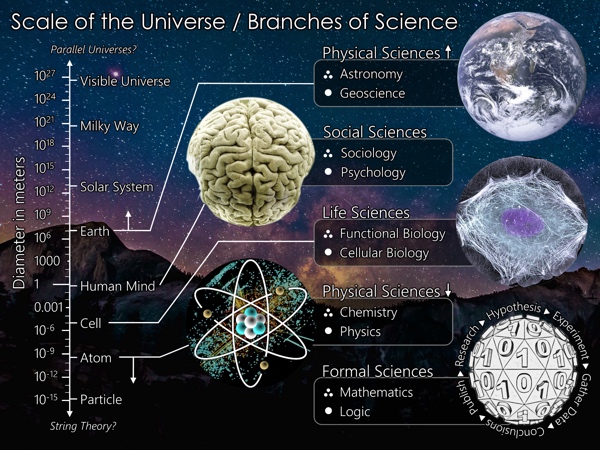
In my last essay I wrote about the intersection of science, technology, and society, along with how the intersection of those three is tricky, but important, to understand.
Okay, then let’s try to tackle something perhaps easier: what do we mean by “science”?
I think we all have an idea in our head of a “scientist,”. You’re probably picturing someone in a long white lab coat, standing by an equipment and notebook-strewn laboratory table, perhaps also wearing glasses, and either holding a test tube full of bubbling liquid or with their hair standing on end as they rest their hand on an electrostatic generator.
So a scientist is one who does science, and they come in all shapes and sizes, but then how does one do science? What is the nature of science? How can we tell if one person is doing science but another person is not doing science?
These are actually difficult, but important, questions to think about in today’s world, as we have politicians not only ignoring scientific guidance, but trying to turn people against science with anti-intellectual rhetoric. And with the world dealing with issues from climate change, disease, nuclear waste, and other problems, we really do need to get our scientific house in order.
As for the nature of science, most of us are probably most familiar with a characterization of science by Karl Popper, known as one of the greatest philosophers of science. In his article, “Science: Conjectures and Refutations,” Popper gives a set of principles and criteria by which one can distinguish science from pseudo-science. Especially if you want the government to invest money in scientific programs, and if you want people to have confidence in the results of science, you want to be able to clearly demark real science from chicanery, charlatanry, and snake oil.
NB: Why we still have to deal with chicanery, charlatanry, and snake oil in the 21st century is something we should perhaps set aside for another article.
But back to Popper, three of his seven criteria for science are1:
-
“Every ‘good’ scientific theory is a prohibition: it forbids certain things to happen. The more a theory forbids, the better it is.”
-
“A theory which is not refutable by any conceivable event is non-scientific. Irrefutability is not a virtue of a theory (as people often think) but a vice.”
-
“Every genuine test of a theory is an attempt to falsify it, or to refute it. Testability is falsifiability; but there are degrees of testability: some theories are more testable, more exposed to refutation, than others; they take, as it were, greater risks.”
So these criteria help us to know good science: it has to be falsifiable, refutable, and testable. If it’s not, it’s not science.
But is Popper the last word on the nature of science? Some would say no. As one example to consider for why not, if you take a historical look at the history of science, science does not always follow the rules handed down by Popper. This point has been influentially made in Thomas Kuhn’s “The Structure of Scientific Revolutions,” where he created a “new day” for science in providing evidence-based science norms by looking at historical evidence.
In that work Kuhn is perhaps most known for introducing the idea of scientific paradigms, a nebulously-defined phrase perhaps approximated as the collection of background assumptions, beliefs, tacit knowledge, and culture that a particular scientific community holds and follows. Kuhn detailed how science progresses through revolution to the new paradigm after a period of crisis in the old paradigm.
In fact, while Kuhn was specifically addressing scientific paradigms here, his work was so influential that other fields — eg non-scientific fields — borrowed his ideas and frameworks. So if your boss comes to you talking about how we need a “paradigm shift” in the next product or release, you can roll your eyes and thank Kuhn (and maybe have a talk with your boss about why he or she is misusing “paradigm shift” — or maybe you shouldn’t have that talk with your boss, if you want to keep your job).
But most notable for our discussion here is his demonstration from historical evidence that science does not always follow the Popperian path from one rational belief to another. Sometimes which scientific path to follow by a scientist is not exactly a rational decision2:
That is one of the reasons why prior crisis proves so important. Scientists who have not experienced it will seldom renounce the hard evidence of problem-solving to follow what may easily prove and will be widely regarded as a will-o‘-the-wisp. But crisis alone is not enough. There must be a basis, though it need be neither rational nor ultimately correct, for faith in the particular candidate chosen. Something must make at least a few scientists feel that the new proposal is on the right track, and sometimes it is only personal and inarticulate aesthetic considerations that can do that. Men have been converted by them at times when most of the articulable technical arguments pointed the other way. When first introduced, neither Copernicus’ astronomical theory nor De Broglie’s theory of matter had many other significant grounds of appeal. Even today Einstein’s general theory attracts men principally on aesthetic grounds, an appeal that few people outside of mathematics have been able to feel.
Much of today’s science has been shaped by the criteria set forth by Popper to demark science from pseudo-science, but Kuhn has shown us that the history of science has not always followed the ideal rational model many of us have in our heads about science. Yet science, for hundreds of years, has been our best method for creating knowledge about nature — it’s our main knowledge-generating engine. It’s how we claim to know the Truth.
So, how do scientists construct the Truth about nature? To address that we’ll need to journey further down this rabbit hole.